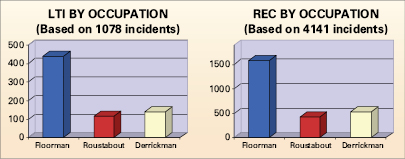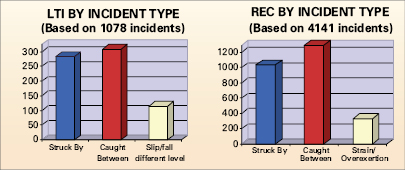IADC Incident Statistics Program shows industry set record-low LTI rate in ’08, but fatalities go up
Good news: The global drilling industry pushed its lost-time incident (LTI) rate to a record low of 0.49 in 2008. Not-so-good news: The number of fatalities increased from 23 in 2007 to 32 last year, according to the latest IADC Incident Statistics Program (ISP) summary.
 A total of 32 fatalities were reported by drilling contractors in 2008, boosting the incidence rate to 0.014. In 2007, the incidence rate was 0.010 with 23 fatalities. The graphs above break down fatalities by activity, type, occupation and time in service.
A total of 32 fatalities were reported by drilling contractors in 2008, boosting the incidence rate to 0.014. In 2007, the incidence rate was 0.010 with 23 fatalities. The graphs above break down fatalities by activity, type, occupation and time in service.
A total of 105 contractors, representing approximately 78% of the worldwide rig fleet, participated in the 2008 program, which has tracked safety and accident information for the drilling industry since 1962. Data here account for 454.47 million manhours worked, during which a total of 1,078 LTIs and 4,141 recordable incidents were reported.
Incidence rates are calculated on incidents per 200,000 manhours. Data are compiled separately for land and offshore operations and for seven geographic regions – US, Europe, Canada, Central & South America, Africa, Middle East and Asia Pacific.
FATALITIES
With a total of 32 fatalities reported in 2008, the incidence rate went up to 0.014, compared with 2007’s 0.010. Employees with less than six months of service with the company accounted for 12 fatalities, the largest percentage. Six victims had worked for the company between one to five years; five had between six months to one year of service; five had more than five years; four were unknown.
By region, six of the fatalities occurred in the Middle East, 15 in the US, four in Central and South America, five in Africa and two in Asia Pacific.
By position, the largest percentages were floorman and supervisors of driller or above, each accounting for eight fatalities. Crane operator, derrickman, motorman/mechanics, roustabout, welder and unclassified accounted for the other 16 deaths.

As with previous years, in 2008 the floorman position suffered the largest percentage of lost-time injuries and recordable incidents.
SUMMARIES BY REGION
For land operations, as in 2007, the Middle East had both the overall lowest LTI rate and the lowest recordable incidence rate of the seven regions. Offshore, the US had the lowest LTI rate while the Middle East had the lowest recordables rate.
Europe: Contractors in this region worked more than 45.8 million manhours in 2008 – 38.01 million offshore and 7.76 million onshore.
European land workers improved their LTI rate 4% from 0.48 to 0.46 and improved recordables by 35% from 1.79 to 1.16.

Fingers are still the most vulnerable part of the body, statistics show.
European offshore workers were able to reduce their LTI rate by 34% from 0.41 in 2007 to 0.27 in 2008. Their recordables rate also was reduced, by 11% from 1.11 to 0.99.
No fatalities were reported in this region.
United States: Contractors here worked a total of 146.51 million manhours, with 106.85 million on land and 39.67 million offshore.
US land workers improved both their LTI and recordables rates in 2008. The LTI rate went down 16% from 1.23 to 1.03, while the recordables rate went down 19% from 5.06 to 4.11.
Twelve fatalities were reported on US land operations and three on offshore operations.

For both LTIs and recordables, “struck by” and “caught between” took up the largest percentages. “Slip/fall different level” and “strain/overexertion” were other top causes.
Middle East: This region accounted for 95.67 million manhours, with 71.92 million on land and 23.76 offshore.
Land contractors maintained their 2007 LTI rate of 0.28 for 2008 and improved their recordables rate by 10% from 1.03 to 0.93. Offshore workers saw their LTI rate worsen 33% from 0.15 to 0.20 while their recordables rate improved 7% from 0.90 to 0.84.
Five fatalities occurred on land and one fatality offshore, for a total of six in this region.

“Pipe/collars/tubulars” is the equipment category responsible for the most lost-time injuries and recordable incidents.
Africa: A total of 52.41 million manhours were reported here, 29.36 million on land and 23.04 million offshore.
Land workers in this region saw their LTI rate worsen slightly from 0.61 to 0.62 while their recordables rate improved 5% from 1.78 to 1.70. Offshore workers’ LTI rate worsened by 42% from 0.28 to 0.40. The offshore recordables rate worsened 3% from 0.90 to 0.93.
Three fatalities were reported on land operations and two fatalities were reported on offshore operations, for a total of five in this region.

By activity, “tripping in/out” is the operation that involves the most lost-time and recordable injuries.
Asia Pacific: Contractors in this region worked a total of 50.55 million manhours. Of that, 34.40 million were offshore and 16.16 million were onshore.
The land LTI rate here worsened 14% from 0.35 to 0.40 while the land recordables rate improved 12% from 1.19 to 1.05.
Offshore workers did not fare as well, with their LTI rate worsening 129% from 0.17 to 0.39 and their recordables rate worsening 9% from 1.05 to 1.15.
Two fatalities were reported in this region, one each from land and offshore.

As with past years, by far the most injuries in drilling operations occur on the rig floor.
Central and South America: This region accounted for 60.06 million manhours, including 38.55 million on land and 21.51 million offshore.
Land contractors in this region improved their LTI rate 9% from 0.32 to 0.29 and improved their recordables rate 5% from 1.11 to 1.05. Offshore workers also were able to reduce their numbers: LTI rate by 23% from 0.44 to 0.34 and recordables rate just slightly from 1.35 to 1.34.
Four fatalities were reported in this region, two each from land and offshore.

Employees with between one to five years of service had the highest number of LTIs and recordables, followed by those with less than three months of service.
Canada: Contractors here accounted for 3.45 million manhours – 2.71 million on land and 0.74 million offshore.
Land workers improved their LTI rate 42% from 1.02 to 0.59, while their recordables improved 10% from 2.70 to 2.43. Offshore workers, however, saw their LTI rate worsen 116% from 0.25 to 0.54. Their recordables rate worsened similarly, by 120% from 1.10 to 2.43.

09:00-10:00 hours, 10:00-11:00 hours and 16:00-17:00 hours were the leading categories in lost-time injuries and recordable incidents by time of day.
OTHER FINDINGS INCLUDED:
- • By occupation, the floorman position suffered the largest percentage of injuries, similar to previous years.
- • By body part, fingers were still the most vulnerable part of the body.
- • By incident type, “struck by” and “caught between” accounted for the most incidents.
- • By equipment, pipes/collars/tubulars was the equipment category responsible for the most LTIs and recordables.
- • By activity, tripping in/out involved the most lost-time and recordable injuries.
- • By location, by far the most injuries in drilling operations occur on the rig floor.
- • By time in service, employees with between one to five years of service had the most LTIs and recordables, followed by employees with less than three months of service.
- • By time of day, the most LTI and recordable incidents occurred between 10:00-11:00 hours.
- • By month, June accounted for the most LTIs while August accounted for the most recordables.

The months of May through August saw the highest numbers of lost-time injuries and recordable incidents.
For more information about the IADC Incident Statistics Program, please contact IADC regional vice president North America & lead staff land HSE issues Joe Hurt at +1/713-292-1945 or joe.hurt@iadc.orgThis e-mail address is being protected from spam bots, you need JavaScript enabled to view it . DC
|





Missing offshore data for U.S. in regionals. ??